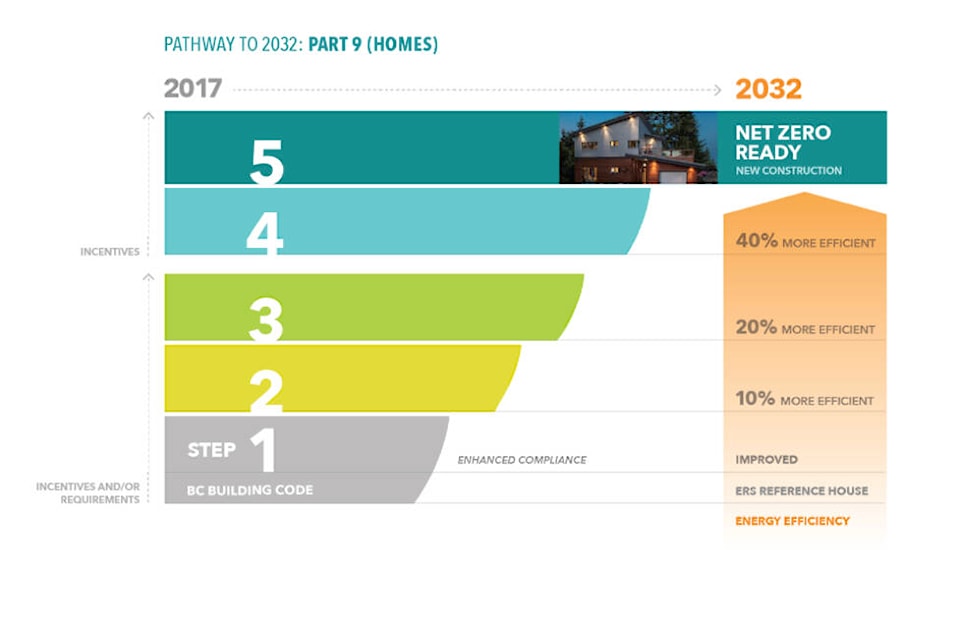Rural communities could be adversely affected should the province mandate the building Step Code, which has five steps leading to net-zero homes by 2032, according to a Thompson-Nicola Regional District (TNRD) report presented during a committee of the whole (COTW) meeting on April 22.
In the report, TNRD staff note that the BC Step Code could be mandatory by the end of 2022, and expected the topic to come up in the annual Southern Interior Local Government Association (SILGA) and Union of BC Municipalities (UBCM) gatherings. Therefore, a “primer” presentation was given during the COTW to prep the board and mayors of member municipalities before attending the gatherings.
“I was really trying to target the elected officials that are representing rural community residents that are going to be facing a challenge to build a new home in the future,” said Tony Bolton, TNRD chief building inspector.
Step 3 of the BC Energy Step Code requires air tightness by contracting with an energy advisor, and exceeding the B.C. Building Code energy efficiency by 20 per cent. Homes built under Step 3 require an air-tightness test performed by a certified energy advisor (CEA), adding more costs to the overall building cost. This is in addition to the materials and labour costs required to meet the building requirements.
Many municipalities in B.C. have adopted the BC Energy Step Code, including Richmond, Whistler and Kelowna. The City of Kamloops adopted the BC Energy Step Code in 2018, and as of Jan. 1, 2022, building permits must show compliance to Step 3 for new residential buildings.
Bolton said staff looked to establish a rough estimate of how much more it would cost rural residents to build a home under the Step Code. He said they were able to verify that just three CEAs are stationed in Kamloops, the closest city centre for many residents in the TNRD. There are about 75 CEAs throughout the province.
According to information gathered by TNRD staff, a CEA would need to visit the home two, maybe three, times to perform tests to ensure air tightness. These blower door tests cost about $587 each, plus a $150 mid-construction report, meaning two visits from a CEA would cost roughly $1,324 before taxes.
But many CEAs charge for travel, especially when outside city limits. TNRD staff found on average the cost was $85 per hour and $0.65 per kilometre to have a CEA travel to a rural community. A new home being built just an hour away from Kamloops would incur costs of about $2,335 for both tests. On top of that is the cost of the materials and labour required to be Step 3-compliant, which could be up to another $21,000.
The report noted numerous challenges with the Step Code in the TNRD, including travel time and distance to hamlets and small municipalities, lack of CEAs and their “unconfirmed willingness to travel” and a reliance on manufactured homes, which are not Step Code compliant.
Bolton said they wanted to point out that the Step Code attempts to treat everyone equally, when in reality, for those in rural or remote areas, it may not be as feasible to accomplish. For example, many homes in rural B.C. require supplemental heat, such as fireplaces and wood stoves. Under the Step Code, these appliances are a liability to air tightness because the chimneys and piping add additional holes to the building.
“They’re trying to keep one standard,” said Bolton. “But I don’t know that it really reflects what’s happening.”
He added there are alternatives the province could look into, such as where the construction occurs. The vast majority of new homes, according to the report, are built in urban centres and the Lower Mainland, and therefore the province’s climate goals could be met without having to add costs or delays to home building in rural and remote areas.
Another alternative is to create a different standard for new rural and remote homes.
“A modest, well-insulated 1,000 sq. ft. bungalow in a rural setting should not be subject to the same regulation that applies to a 4,000 sq. ft.-plus house with a wall of south-facing windows and a black roof with 10-fold AC and heating on demand,” the report reads.
Considering the demand for new homes, the BC Energy Step Code could add substantial costs to new developments in small communities. But it would also create a potential new market.
“If it does become mandatory, I could recommend there’s a line of work for people, there’s going to be opportunities for energy advisors in small communities,” said Bolton. “It just comes at the expense of every (new) homeowner.”
For more information about the BC Energy Step Code visit energystepcode.ca.
